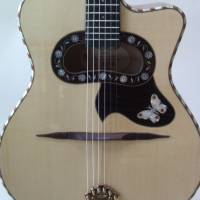DjangoBooks.com
Welcome to our Community!
Categories
- 20K All Categories
- 1.1K General
- 478 Welcome
- 59 Archtop Eddy's Corner
- 146 CD, DVD, and Concert Reviews
- 385 FAQ
- 26 Gypsy Jazz Italia
- 27 Photos
- 202 Gypsy Picking
- 21 Unaccompanied Django
- 15 Pearl Django Play-Along Vol.1
- 17 Gypsy Fire
- 45 Gypsy Rhythm
- 1.4K Gypsy Jazz University - Get Educated
- 131 Gypsy Jazz 101
- 227 Repertoire
- 221 History
- 708 Technique
- 51 Licks and Patterns
- 6 Daniel Givone Manouche Guitare Method Users Group
- 20 Eddie Lang Club
- 1.3K Gypsy Jazz Gear
- 802 Guitars, Strings, Picks, Amps, Pickups and Other Accessories
- 461 Classifieds
- 49 Recording
- 62 Other Instruments
- 18 Violin
- 5 Mandolin
- 22 Accordion
- 7 Bass
- 10 Woodwinds
- 348 Gypsy Jazz Events
- 143 North America
- 110 Europe
- 95 International
In this Discussion
Does higher string tension help you play faster??
 constantine
New York✭✭✭✭ Geronimo Mateos
constantine
New York✭✭✭✭ Geronimo Mateos
I have a short scale GJ guitar and I love it because its easy to play. On the other hand I wonder if the lower string tension will stunt gypsy picking and overall speed. Thanks.
C
C









Comments
But there are many other variables including the the guitar you're playing (some guitars sound better with less string tension), how you play (some people are just naturally aggressive players and simply can't play guitars setup for easy playability), etc.
'm
I've only seen loose string tension slow one guy down. A while back, Larry Coryell did a couple of shows at Djangofest using a short-scale quasi-gypsiesque electric guitar... at any rate... he was picking directly over the center of the soundhole and you could tell that there was a lot of squish in the strings. When he did fast runs - it sounded like his pick was running into the string as they were rebounding - like he was chasing the strings around the guitar. But that's a worst-case circumstance... a guy used to playing heavy strings playing light strings and strumming over the soundhole and really cookin on a lot of single string runs.
Learn how to play Gypsy guitar:
http://alexsimonmusic.com/learn-gypsy-jazz-guitar/
Players like Moreno for exemple can't play on 010 without breaking strings
i've tried guitars with higher action and 11s that felt like butter, and guitars with 10s and low action that were so hard to play.
this is very interesting, because it's a question i've asked every luthier, no one so far has been able to give me a clear response... and i was talking about it with so many people at samois and even django in june..
i'm sure the neck angle/truss rod adjustment has a bit to do with it, but there appears to be more invovled since some luthiers/techs aren't able to recreate the feel that i want on certain guitars... while on others it's really easy...
www.denischang.com
www.dc-musicschool.com
On my Vielle Reserve, I have to play with very low action to access the sweet spot. That's the only way I can play close to the bridge. Set up with a low action, it gets one of the most cutting/clear sounds I've heard. A lot of classicals, and my ex-12 fret d-hole had very big sweet spots. I think this has more to do with the type of strings + the height of the bridge in relation to the type of bracing and placement of the bridge on the lower bout than the distance between the strings and the fret board (action). There's got to be some kind of AutoCAD way of showing how these things all affect each other...
When I've played a cello, violin, or even upright bass, I've noticed that in comparison to most guitars, those instruments are proportionately much easier to fret..and they are often louder!!!
I believe that less tension gives the player more control..you can add the tension and bring up the fundamental tone with a fatter pick (not too fat though..maybe like 3-5mm).
If the strings are to tense/brittle feeling, you can't get the pick wrapped up in them, and it's hard to make the overtones sing.
Look/listen to Django...he plays so close to the bridge, but you can hear the sweet, soft legato...and he also has the option of overdriving/over-saturating the overtones if he wants. There's more dynamic range with less tension.
But it's also important to have high action, so that when you do dig in, the lower tension strings/setup will have enough room to vibrate without crapping out by hitting the frets.
I'm pretty sure that the guys with the biggest vibrato (Stochelo, Jimmy) can only get that feel with lower tension (light gauge) strings. And I believe that they use the silk and steel 10s.
Learn how to play Gypsy guitar:
http://alexsimonmusic.com/learn-gypsy-jazz-guitar/
Stochelo religiously uses 11 gauge silk and steel strings, usualy D'Adarrio or Galli. Although recently he's been using nickel Elixers as well...but my guess is that he uses those because they work nicely with a Stimer. When's he's playing acoustic my guess is that he sticks with the Silk and Steel.
I have found that rest stroke works very well, for me at least, with high tension, and have used it on solidbody (sparingly) and arch top, as well as flat top. I have .013 guage strings on a telecaster and use rest stroke for some stuff, alternate for others. My arch top also has .013. The difference is the pick. I would not use a 3 mm Wegen on my solidbody. I have found that a stiff thin pick works well for me on all guitars, but I usually select different picks for tone.
Also, early players like Eddie Lang used lots of down strokes, on arch tops with heavy strings/high tension.
Mike